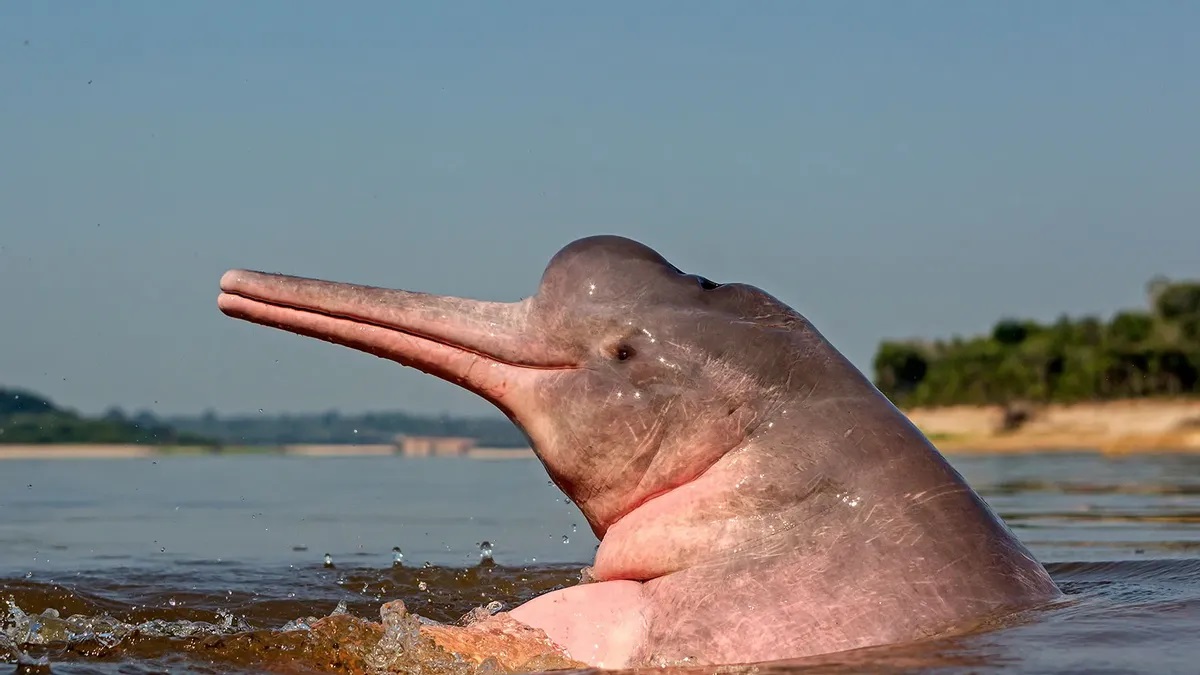
The Amazon River dolphin, also known as the pink river dolphin, is a fascinating and enigmatic creature that inhabits the freshwater rivers of the Amazon Basin in South America. With its distinctive pink coloration and unique physical adaptations, this elusive species has captured the imagination of people around the world. From its evolutionary history to its ecological significance, the Amazon River dolphin is a subject of great interest for scientists, conservationists, and nature enthusiasts alike.
In this article, we will delve into 27 captivating facts about the Amazon River dolphin, shedding light on its behavior, habitat, conservation status, and cultural significance. From its mysterious underwater world to its interactions with humans, the Amazon River dolphin continues to intrigue and inspire awe. Join us as we embark on a journey to uncover the secrets of this extraordinary creature, exploring its role in the rich tapestry of the Amazon rainforest and the rivers that flow through it.
Key Takeaways:
- The Amazon River Dolphin, also known as the pink river dolphin, is the largest river dolphin species, with a captivating pink coloration and remarkable cognitive abilities. It faces conservation challenges due to habitat degradation and is deeply rooted in Amazonian folklore and mythology.
- The Amazon River Dolphin serves as a symbol of ecological interconnectedness and is a flagship species for conservation efforts in the Amazon and Orinoco river basins. Its acrobatic displays and vocalizations add to its charismatic appeal, inspiring awe and wonder worldwide.
The Amazon River Dolphin: A Fascinating Creature of the Amazon
The Amazon River Dolphin, also known as the pink river dolphin or boto, is a captivating and enigmatic species that inhabits the freshwater regions of the Amazon and Orinoco river basins in South America. Renowned for its striking pink coloration and unique physical characteristics, the Amazon River Dolphin has long been a subject of fascination for researchers, conservationists, and nature enthusiasts alike. Let's dive into the 27 best Amazon River Dolphin facts to uncover the remarkable traits and behaviors that make this species truly extraordinary.
The Amazon River Dolphin is the largest river dolphin species.
Measuring up to 8 feet in length and weighing as much as 185 kilograms, the Amazon River Dolphin holds the title as the largest river dolphin species in the world. Its substantial size and robust build distinguish it from other river dolphins, contributing to its iconic status in the waterways of South America.
The Pink Hue of the Amazon River Dolphin is Unique Among Cetaceans.
The mesmerizing pink coloration of the Amazon River Dolphin sets it apart from its marine counterparts. Unlike the typical gray or blue hues found in most dolphins, the Amazon River Dolphin exhibits a captivating pink complexion, which intensifies when the dolphins are excited or experiencing strong emotions.
The Amazon River Dolphin navigates murky waters using echolocation.
In the turbid environments of the Amazon and Orinoco rivers, where visibility is limited, the Amazon River Dolphin relies heavily on echolocation to navigate, communicate, and locate prey. This remarkable ability enables them to thrive in challenging aquatic habitats.
The species exhibits sexual dimorphism.
Male Amazon River Dolphins are notably larger than females and possess distinct physical features, including a pronounced, elongated snout called a "rostrum." This sexual dimorphism contributes to the species' intriguing dynamics and behavior within their social groups.
The Amazon River Dolphin is highly sociable and communicative.
These dolphins are known for their gregarious nature, often forming complex social structures and engaging in a wide array of vocalizations and body language to convey messages and establish bonds within their pods. Their communicative prowess adds depth to their captivating social interactions.
The species is deeply rooted in Amazonian folklore and mythology.
The Amazon River Dolphin holds a significant place in the folklore and mythology of indigenous Amazonian cultures. Revered as a mystical and supernatural being, the dolphin is the subject of numerous legends that depict its transformative abilities and spiritual connections to the rivers and rainforests.
The diet of the Amazon River Dolphin consists of various freshwater species.
Feeding primarily on fish, crustaceans, and even the occasional turtle, the Amazon River Dolphin plays a crucial role in regulating the ecosystem of the Amazon and Orinoco river basins. Their dietary habits contribute to the intricate balance of aquatic life in the region.
The species faces conservation challenges due to habitat degradation.
The Amazon River Dolphin confronts threats stemming from habitat loss, pollution, and human encroachment. As the Amazon and Orinoco river ecosystems undergo rapid transformation, efforts to safeguard the habitats of these iconic dolphins are essential for their long-term survival.
Amazon River Dolphin populations are distributed across multiple countries.
The range of the Amazon River Dolphin spans several South American nations, including Brazil, Bolivia, Colombia, Ecuador, Peru, and Venezuela. This broad distribution underscores the species' significance in the diverse ecosystems of the Amazon and Orinoco river basins.
The species is classified as "Data Deficient" by the IUCN.
Despite its cultural and ecological importance, the conservation status of the Amazon River Dolphin remains a subject of uncertainty. The International Union for Conservation of Nature (IUCN) has categorized the species as "Data Deficient," highlighting the need for comprehensive research and conservation initiatives.
The Amazon River Dolphin is a symbol of ecological interconnectedness.
As a keystone species in its habitat, the Amazon River Dolphin serves as a symbol of the intricate interconnectedness of the Amazon and Orinoco river ecosystems. Its presence influences the dynamics of the aquatic food web and reflects the health of the surrounding environment.
The species is the subject of ongoing scientific research and conservation efforts.
Researchers and conservation organizations are dedicated to unraveling the mysteries of the Amazon River Dolphin and implementing measures to protect its future. Through collaborative studies and community engagement, initiatives are underway to safeguard the well-being of these captivating creatures.
The Amazon River Dolphin's pink coloration deepens with age.
Young Amazon River Dolphins are often gray in color, gradually transitioning to a rosy hue as they mature. This unique transformation adds a layer of intrigue to the species' life cycle and contributes to its distinctiveness within the realm of cetaceans.
The species exhibits remarkable cognitive abilities.
Studies have demonstrated the Amazon River Dolphin's advanced cognitive capacities, including problem-solving skills and complex social behaviors. Their cognitive prowess underscores the species' intelligence and adaptability in its dynamic freshwater environment.
The Amazon River Dolphin is a flagship species for conservation.
Given its charismatic appeal and ecological significance, the Amazon River Dolphin serves as a flagship species for conservation efforts in the Amazon and Orinoco river basins. By prioritizing the protection of the dolphin's habitats, conservation initiatives aim to safeguard a multitude of interconnected species and ecosystems.
The species is known for acrobatic displays.
Amazon River Dolphins are adept at performing acrobatic feats, including graceful leaps and spins above the water's surface. These displays not only showcase the dolphins' agility but also serve as captivating spectacles for observers along the riverbanks.
The Amazon River Dolphin possesses a flexible neck structure.
Unlike marine dolphins, the Amazon River Dolphin exhibits a flexible neck structure that enables it to maneuver through the intricate network of waterways and flooded forests in its habitat. This physical adaptation contributes to the species' adeptness in navigating diverse aquatic landscapes.
The species is vulnerable to entanglement in fishing gear.
Incidental capture in fishing nets poses a significant threat to the Amazon River Dolphin population. Conservation efforts seek to mitigate these risks through the implementation of sustainable fishing practices and the development of dolphin-friendly gear.
The Amazon River Dolphin is a subject of cultural festivals and celebrations.
In various Amazonian communities, the presence of the Amazon River Dolphin is commemorated through vibrant festivals and traditional ceremonies. These cultural celebrations reflect the deep-rooted connection between local populations and the iconic dolphins.
The species' vocalizations are diverse and expressive.
Amazon River Dolphins communicate through a rich repertoire of vocalizations, encompassing clicks, whistles, and intricate patterns of sound. These expressive vocalizations play a pivotal role in the dolphins' social interactions and navigation within their aquatic environment.
The Amazon River Dolphin is an indicator of ecosystem health.
The presence and well-being of the Amazon River Dolphin serve as indicators of the overall health and resilience of the Amazon and Orinoco river ecosystems. Monitoring the status of the dolphin populations provides valuable insights into the conservation needs of the region.
The species exhibits maternal care and nurturing behavior.
Female Amazon River Dolphins demonstrate remarkable maternal instincts, displaying attentive care and nurturing behavior towards their offspring. The bond between mother and calf is a testament to the species' familial dynamics and emotional depth.
The Amazon River Dolphin is a subject of ongoing eco-tourism initiatives.
In regions where the species is found, eco-tourism initiatives centered around the Amazon River Dolphin offer opportunities for sustainable engagement with local ecosystems. These initiatives promote conservation awareness and support the economic well-being of surrounding communities.
The species is intertwined with indigenous traditions and beliefs.
Indigenous cultures hold profound reverence for the Amazon River Dolphin, viewing it as a symbol of wisdom, protection, and spiritual significance. The dolphins' presence is intricately woven into the fabric of traditional belief systems and practices.
The Amazon River Dolphin embodies the resilience of Amazonian biodiversity.
Amidst the complex environmental challenges facing the Amazon and Orinoco river basins, the Amazon River Dolphin symbolizes the resilience and adaptability of the region's diverse aquatic life. Its enduring presence underscores the intrinsic value of preserving the Amazon's natural heritage.
The species inspires awe and wonder, captivating hearts worldwide.
From its captivating pink hues to its captivating behaviors, the Amazon River Dolphin continues to inspire awe and wonder, captivating the hearts of individuals worldwide. Its enigmatic allure serves as a reminder of the boundless marvels found within the Amazon and Orinoco river ecosystems.
As we unravel the 27 best Amazon River Dolphin facts, we gain a deeper appreciation for the remarkable attributes and ecological significance of this iconic species. From its cultural resonance to its pivotal role in freshwater ecosystems, the Amazon River Dolphin stands as a testament to the profound interconnectedness of nature and the enduring spirit of the Amazon.
Conclusion
The Amazon River dolphin, also known as the pink river dolphin, is a fascinating and unique creature that inhabits the Amazon River basin. With its striking pink coloration and remarkable adaptations, this species has captured the curiosity of people around the world. From its social behaviors to its sensory abilities, the Amazon River dolphin continues to intrigue researchers and nature enthusiasts alike. By understanding the importance of conservation efforts and promoting sustainable practices, we can contribute to the preservation of this iconic species and the delicate ecosystems it calls home.
FAQs
What is the significance of the pink coloration of Amazon River dolphins?
The pink coloration of Amazon River dolphins is attributed to the abundance of blood vessels near the skin's surface, which helps regulate body temperature and aids in thermoregulation. Additionally, the coloration may serve as a form of communication and social signaling among individuals within the species.
How can individuals contribute to the conservation of Amazon River dolphins?
Individuals can support the conservation of Amazon River dolphins by raising awareness about the threats they face, such as habitat destruction and pollution. Additionally, supporting organizations and initiatives dedicated to protecting the Amazon River basin and its diverse wildlife can make a significant impact on the preservation of these unique dolphins.
Was this page helpful?
Our commitment to delivering trustworthy and engaging content is at the heart of what we do. Each fact on our site is contributed by real users like you, bringing a wealth of diverse insights and information. To ensure the highest standards of accuracy and reliability, our dedicated editors meticulously review each submission. This process guarantees that the facts we share are not only fascinating but also credible. Trust in our commitment to quality and authenticity as you explore and learn with us.


